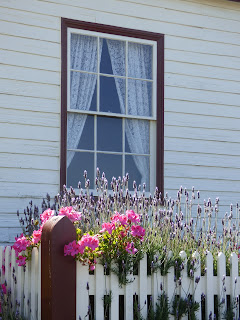We have just spent two weeks in Tasmania as part of my birthday celebrations (a month earlier to avoid the crowds and higher Christmas prices). We enjoyed our visit but were not prepared for the endless warm weather. For almost the whole of our time the temperature wavered between 27 and 33 degrees.
First stop was an overnighter at Wynyard on the north coast and I only mention this because for dinner we had boar fish, a fish I had never heard of before, and I must say it was absolutely delicious.
Stanley, sitting on an exposed peninsula, is a delightful town, carefully restored. It nestles in the shadow of an ancient volcanic plug known as The Nut.

We ventured to the coast at Rocky Cape National Park...
... and followed the sign to a shelter used by the Aborigines.
Visiting the historic Highfield House was a highlight for me. We had last visited when restoration had just begun around 1994. Now it is elegantly restored and evocative of the 1830s when it was built for Edward Curr, the chief agent of the Van Diemen's Land Company. The company was formed in London as a prominent sheep breeding operation. It subsequently failed, but the company's personnel were the first Europeans to settle this remote north-west corner of Tasmania.
Then it was off to Smithton, another isolated town in the far north-west. We had two full days here. The first day we drove the Arthur-Pieman Coastal Drive, calling in at beaches where the Southern Ocean pounded the shore, driftwood piled precariously on the beaches, the gale-force winds blew relentlessly and the sea grasses were buffeted, bowed but unbeaten.
It made walking very difficult.
But there were pretty coves with turquoise waters and rust-coloured rocks.


...to a fascinating sinkhole called the Trowutta Arch, a rare geological feature. I loved it. The sinkhole is seen through an overhanging arch creating an atmosphere of mystery. The reflections in the water were beautiful but it was impossible to capture the essence of this place because of the sunshine. The photo does not really do it justice (this was Steve's best photo of the sinkhole, mine were useless).
Next stop was at Rapid River where we rambled through a dense forest alongside the river.
Then we drove to another sinkhole that really looks like a lake, hence its name: Chisholm Lake. The walk to the lake was through another lovely forest.

 |
| This lake is said to be one of the finest examples of a flooded limestone sinkhole in Australia. |
The final stop was at the Sumac Lookout which gave us a breathtaking view over the Arthur River and the surrounding cool temperate rainforest.
So ends our north-west adventure. Next blog, we turn south to the Central Highlands.





























Lovely photos! Especially the magnificent Highfield House gardens
ReplyDeleteFinally getting to read your adventures.
ReplyDeleteXXXX